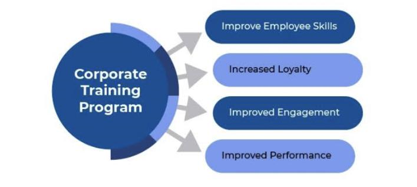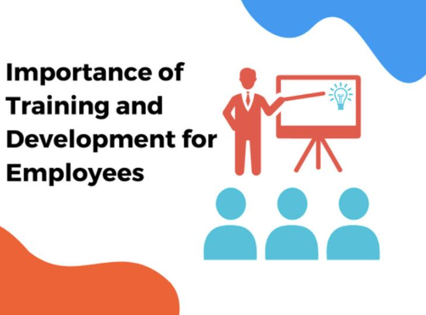To boost staff abilities and propel the business forward, corporate training programs are important. Targeted educational opportunities that are in line with the company’s aims are what these programs are all about. There are several wins for businesses that invest in their employee’s growth.
To begin with, corporate training programs provide workers with the information and expertise they need to do their jobs well.
Training programs provide a systematic way to learn and improve a wide range of skills, including technical knowledge, leadership qualities, & interpersonal skills. When workers improve their knowledge and abilities, they can do their jobs more effectively and efficiently.
Training programs encourage a mindset of lifelong learning among employees. Companies foster a culture of development and creativity by providing employees with avenues to learn new skills and keep up with developments in their fields.
When workers see opportunities to advance their careers, they are prone to feel committed to their jobs and the company as a whole.
Introduction
Companies understand the need to have knowledgeable and skilled staff. Companies can better adapt to the changing needs of their industries by investing in educational opportunities for their staff.
More than just an introduction to the company and its culture, these programs lay the groundwork for ongoing training and education during an employee’s tenure.
Organizations can tailor training courses to better meet their requirements as well as achieve their objectives. They cover everything from hard skills like math and science to softer ones like people management and critical thinking.
Targeted training programs help businesses guarantee that workers have the skills they need to do their jobs thoroughly and contribute productively to the expansion of the company.

Table of contents:
- What is Employee Training and Development?
- Importance of incorporating training programs
- How Corporate Training Programs Help to Improve Employee Skills?
- Conclusion
What is Employee Training and Development?
When a corporation invests in its employees through development and training, it’s trying to make a long-term investment in their productivity. The organization is committed to the growth and development of its staff and uses a wide range of training and development opportunities to achieve this goal.
There is a significant overlap between “training” & “development,” but these phrases are not synonymous. The difference lies in its breadth of application. The objectives of a training course are specific and quantifiable such as the acquisition of skills in the correct execution of a given program or the operation of a given machine.
On the other hand, the plan’s focus is on helping workers acquire generalizable abilities. It encompasses qualities like leadership, communication, & decision-making.
Importance of incorporating training programs
Enhanced productivity in the workplace is a major gain from participating in business training programs. These courses enable workers to carry out their duties with increased proficiency, certainty, and precision by providing them with the information and training they lack.
Employees who invest in their professional growth are better equipped to face new difficulties and make sound judgments. Because of this, productivity rises and performance improves across the board, to everyone’s advantage.
Furthermore, corporate training programs encourage a mindset of lifelong learning among employees. Keeping abreast with developments in business practices, methods, & trends is essential in today’s dynamic marketplace.
Workers can learn new things, improve their abilities, and adjust to the ever-evolving corporate world thanks to training programs. This mindset of never stopping to learn new things helps businesses to always be one step ahead of the competition.
Corporate training initiatives also boost morale and productivity in the workplace. Companies that support their employees’ efforts to advance their careers demonstrate their commitment to their growth as individuals and as professionals. As a result, this boosts employees’ drive, contentment, and loyalty in the workplace. When workers believe their growth is being fostered, they are more invested in their jobs, which in turn boosts morale and productivity.
See Also: 200+ Best Creative Team Names for Workplace
Training programs at companies are crucial to boosting productivity and morale throughout an organization. These programs help workers gain new skills and keep abreast of developments in their fields by giving them opportunities for focused education and training.
Organizations can gain a lot by investing in their workers’ growth as professionals, including enhanced performance at work, a culture of continual learning, as well as increased employee happiness.
The fast-paced nature of modern business makes corporate training programs crucial for companies that value excellence & want to maximize employee potential.
How Corporate Training Programs Help to Improve Employee Skills?
You can build on the groundwork you lay for your staff during deployment with ongoing education and growth initiatives. These initiatives aid in the cultivation of a competitively skilled labor force.
Developing an edge over the competition will boost your company’s prospects. The following are a few of the advantages that employees can gain from corporate training:
Enhanced productivity
Trained workers are more likely to succeed in their roles. They now know more about how to be safe while performing crucial tasks properly. Staff morale might increase as a result of training that clarifies their positions and duties in the company. This assurance can inspire people to think of novel approaches that will bring about enhanced performance.
Furthermore, with the help of ongoing education, workers can anticipate and adapt to changes in the market. Companies may stay at the forefront of their field and keep up with the competition with the help of competent people while creating industry standards.
Taking care of staff members’ inadequacies
Most workers have certain gaps in their ability to do their jobs effectively. All employees can benefit from educational courses that focus on specific areas of weakness. Everyone in the company will be on the same page after completing the training & development program.
It lessens the number of people in the firm who have to rely on others to get their jobs done. Employees can freely exchange ideas and information, collaborate when appropriate, and complete tasks with minimal oversight and coaching.
Greater corporate flexibility
There will be a rise in the prevalence of flat organizational structures as the number of startups grows. Some of the ones with the greatest potential roles, as well as current employees who are the focus of recruitment efforts at other organizations, may be attracted to this decentralized structure.
To ensure a smooth transition to this new organizational structure and the continued success of the company, investing in staff development is a win-win situation.
Better adaptability
Employees benefit from training and growth plans more than others in comparable businesses who must actively seek out such opportunities on their own. Training employees shows that the organization values them. The training has contributed to a more cooperative atmosphere at work.
Employees may now have access to previously unavailable or unusual types of training. To keep employees happy in their work, it’s important to provide them with possibilities to grow professionally.

Job satisfaction for the employees
While there is a constant influx of novel training methods, there are a few that have stood the test of time. Here are a few of the most common approaches to training and developing staff members:
● Orientation
New hires’ productivity greatly depends on the quality of their orientation training. The method of instruction makes no difference, be it a book, a talk, or one-on-one time.
New hires need to know the company’s history, strategy, purpose, and objectives. The purpose of this training is to acquaint new hires with the norms and expectations of the company. Communication abilities among employees are another area that benefits from these sessions.
● Lectures
When it’s necessary to teach a large group the same material at the same time, this course is a good option. There is no need for additional training, which results in cost savings.
However, there are a few problems with this lesson plan. They prioritize one-way transmissions that leave little room for audience participation. Trainers may also have trouble gauging everyone’s level of comprehension in a sizable class. Therefore, coaching workers can boost output.
● CBT (computer-based training)
The majority of the instruction that managers and workers receive takes the form of IT and online guides. The goal of these classes is not just to disseminate knowledge, but to make it easier to absorb that knowledge.
The primary benefit of online training is that every worker can make use of it at no cost and on their own time. It additionally aids down the overall price tag associated with training staff members for a firm. Spend as little as possible on training by shortening or doing away with it entirely.
Gaining Knowledge and Abilities:
Employees can learn new skills and get familiar with industry best practices by participating in training programs. Training programs provide opportunities for individuals to acquire additional skills that improve their performance on the job, whether those skills be technical skills, soft abilities, or industry-specific knowledge.
Adapt new changes:
The capacity to quickly shift gears and bounce back from setbacks is essential in today’s business world. Modules designed to foster these traits in trainees are commonplace in training programs. Organizations produce a resilient workforce by teaching employees to adapt to new circumstances, overcome obstacles, and pick themselves back up after failure.
Cooperation and collaboration:
Organizational success depends on strong interaction and collaboration. Workshops and other training exercises designed to improve teamwork, communication, and interpersonal skills are common. Employees benefit from enhanced collaboration, creative problem-solving, and closer bonds as a result.
Companies that invest in their workers’ personal and professional growth through training programs generate an environment conducive to lifelong learning. Companies that invest in their employees’ professional development have a more productive, more successful, and more sustainable staff as a result.
Conclusion
Corporate training programs are a primary factor in the development of personnel and the expansion of businesses. Companies may help their employees succeed in their jobs by providing them with well-designed training programs. These initiatives boost productivity on the job, encourage lifelong learning, & energize workers.
Corporate training provides workers with the information and instruction they need to do their jobs well. This results in higher output and enhanced efficiency on the job. In addition, staff members who have participated in training programs are better equipped to face issues head-on & to make educated decisions that benefit the business as a whole.








